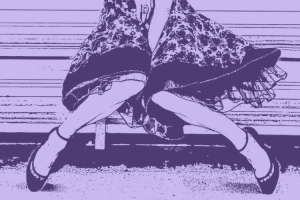“But you speak English!” “You eat hamburgers and pizza.” “You use forks!” “You wear jeans.” “Your name, Rachel, appropriates from White people!”
So, basically, living in the United States, if I don’t only do things stereotypically marked as “Asian,” I’m appropriating from White culture? And, if I do whatever non-Asian folks imagine “being Asian” looks like, I’m told, “Go back to China?”
My family isn’t from there by the way.
There’s been a lot of back and forth lately in discussions of appropriation that question the incorporation of “White culture” into people of color’s day to day lives.
When White folks claim that people of color are appropriating their culture, there is a misunderstanding of what is actually meant by appropriation. Saying, “Hey! It’s appropriation when Asians speak English!” or “If we can’t wear dreads, then black folks can’t straighten their hair” is an inaccurate oversimplification of cultural appropriation.
They ask, “So you borrow from our culture, but we can’t take from yours?”
Not only does this question re-center a conversation about the appropriation of marginalized communities’ cultures around the feelings and needs of White people, but cultural appropriation cannot be simplified to just the act of experiencing another culture – whether that’s traveling, eating food, or appreciating art.
When thinking about cultural appropriation, one of the first things that came to mind for me were how things from my culture that were seen as bizarre and weird when I was growing up are now being viewed as “trendy.”
Like how the herbal soups my mom made for when I was sick was seen as strange-smelling with weird little orange things, but now goji berries are a hot superfood.
But, cultural appropriation is more complicated than people outside of my descent starting to incorporate my culture into their day-to-day lives.
We need to think about how power and privilege work in discussions of cultural appropriation.
Appropriation is ultimately about power. Cultural appropriation refers to a specific power dynamic where members of a dominant culture take elements from a culture of people that they continue to systematically oppress.
We have think about what is actually being communicated when aspects of culture are taken in piecemeal.
A group whose culture has been minimized, disenfranchised, and marginalized can’t appropriate from a culture who has the power to demean and disadvantage other cultures.
So, this is not a conversation about when people of color appropriate from other communities of color — that’s a different discussion all together. Yes, it is possible for people of color to appropriate other cultures, but in the United States, it is not possible for people of color to appropriate culture from White folks.
There’s no such thing as “reverse” cultural appropriation and here’s why:
1. ‘Dominant Culture’ or ‘White Culture’ Defines Everyone Else’s Reality
Try this: Think about how many famous white visual artists you can name. How many artists of color can you think of?
Whether or not you know much about art or whose work is hanging up in museums right now, I’m betting there’s a big chance you can name way more white artists than people of color.
These are issues of access, opportunity, and representation that all manifest in one clear message about whose culture is worth knowing, worth sharing widely, and worth valuing.
Dominant culture – so in the case of the US, White culture – is the one that is perceived as normal, as part of the status quo. It’s an ever present part of everyone’s reality, no matter their background.
In fact, it’s considered so normal, that it’s hard to name precisely what White culture specifically is. We are socialized to live it, believe in it, and accept it. It’s internalized within us.
In the US, often when people refer to Americans or “American culture,” they’re also referring specifically to Whiteness. All other cultural backgrounds get a qualifier, such as Asian Americans, Black Americans, Latinx Americans.
I grew up in a predominantly white and middle class suburb in the Midwest and later went to college in mid-Missouri. Whiteness was not only the norm, but also constantly reinforced as the cultural standard.
This was evident in the racial identities of teachers and professors in charge of the classroom. It was evident the “canonical” books we were assigned in class like Catcher in the Rye and The Great Gatsby and the history we learned that focused solely on Western civilization including the “discovery” of America.
Different processes, including colonization, turned different groups of European immigrants into the racially elite White community. White culture is the dominant power because it controls everyone’s reality through controlling things like history, language, and culture.
“Reverse” cultural appropriation isn’t possible, because our culture supports and enforces Whiteness as the norm.
When a racial group has decided that their culture and lifestyle is the best and only option for everyone else, then it’s not appropriation when others emulate them.
I have to partake in White culture just from the reality of existing in this current moment in time —– I’m not “borrowing” from it simply for my own whimsical pleasures whenever it suits me.
2. Cultural Appropriation Isn’t Just About Borrowing Culture
Often, claims of “reverse” appropriation are the dominant group’s knee jerk reaction to being told something is off-limits. Conversations about what is or isn’t cultural appropriation often end up being a tired discussion about what is or isn’t oversensitive “policing” and forcing people to stay in their own “cultural lane.”
I’ve also heard people say things like, “So, I’m White, does this mean I don’t get to eat dim sum? You’re expecting me to only eat hamburgers my whole life?” Or, “I’m White, does this mean I can’t wear a kimono that I bought in a department store during my trip to Japan?”
The complex nuances of what’s actually at play totally get lost.
Participation and appropriation are totally different things. Cultural appropriation is not just about who does or doesn’t get to participate in, wear, or try other cultures. So, then, the “if I don’t get to wear my hair in cornrows, then you don’t get to have bangs” argument doesn’t really make sense.
The problem with appropriation isn’t that people are incorporating aspects of other cultures into their everyday life — from what they wear, what they eat, and what they consume.
Rather, its the complete erasure of historical context and the total disregard of oppression experienced and endured throughout history.
For example, someone who wears Native headdress or a bindi because it’s now cute and fashionable is taking from another culture’s spiritual and/or cultural practices but not understanding the value and importance.
We need to be more mindful of how cultures and communities get caricaturized and reduced into a singular costume or artifact.
3. There’s a Huge Difference Between Assimilation and Appropriation
Assimilation is when a marginalized group has to take on aspects from the dominant culture for survival.
When my parents first immigrated to the US from Taiwan, they had to learn English and also understand how to navigate institutions and policies to figure out how to get jobs and make an income here. They learned to adopt different behaviors, including American-based cultural traditions, just by living here.
When other groups adopt behaviors that have been coded as White, or as “normal,” in order to gain wealth, employment, or other benefits, that’s not appropriation — that’s trying to survive.
For example, wearing a suit or other “business” attire coded as White in order to appear more professional reinforces pressures to conform with White culture.
Another example of this is comes out of discussions of hair and beauty politics. Maisha Z. Johnson talks about how when Black women straighten their hair, it’s often a matter of survival to be treated with more respect and to be perceived as more “professional.”
The hair of the dominant group of people, White people, and the way they are easily able to cut and style that hair, becomes seen as not only normal, but professionally and socially acceptable. Black hair in its natural state is seen as messy and inferior.
When Beyonce wore a blond wig with side-swept bangs, some folks accused her of appropriating White culture and that it was a double standard to accuse Kylie Jenner of appropriation for wearing cornrows but not Beyonce for rocking the wig and bangs.
Now, while people might argue that Beyonce is so famous that there’s just no way she can experience oppression, it falsely assumes that having privilege automatically erases all other experiences of oppression.
Any conversation about hair and appropriation can’t be reduced down to who gets to wear what hairstyle without a closer examination of the specific power dynamics in racialized beauty politics.
4. Colonization Established the Dominance of White Culture
We also continue to live with the legacies of colonialism that impact our everyday consumption, from shopping for clothes and buying food.
Places that have been colonized, including the United States, forced people in those places to take on the culture of the colonizer by forcibly removing other aspects of culture.
Forced assimilation, emphasis on force, violently removes other cultures.
Groups, such as Indigenous nations, were forced to assimilate, as government policies pushed the removal of language and other traditions.
When Europeans stole people from different parts of Africa to be used as slaves, they tried to strip away any cultural identity. In the US and Canada, Indigenous children were separated from their families to attend boarding schools where they were forced to speak English and adopt Western culture.
“Civilization” disguised as education was a systematic way White culture became dominant.
As communities have worked to resist this systematic removal and hold on to their cultural practice, it’s then effed up when other people then use these cultural artifacts and symbols out of context, just for their own fleeting fun and fashion.
5. White Folks Aren’t Oppressed By Their Racial/Ethnic Culture
Yes, White people in the US have their own ethnic histories full of struggle and hardship as well as cultural traditions that they strongly affiliate with, celebrate, and are proud of.
But because White people are not oppressed racially in the United States or in other Western countries, they are not oppressed by the ways racism extends itself socially, economically, and culturally.
White people are not systematically discriminated against when they practice, wear, or display their cultural traditions.
For example, let’s talk about St. Patrick’s Day, which has often been discussed as a religious holiday that has been stripped of cultural meaning and turned into an excuse for drunken revelry.
Although many immigrants, like Irish, Italian, and Polish immigrants, were oppressed and treated as “non-White” during their arrival in the early 1800s, they gradually were able to become accepted as White as immigration policies determined who was “American” was based on who looked American.
Thus, Irish Americans are no longer systematically disenfranchised for showing off their cultural roots.
I can also guarantee that the reception of a large group of White people participating in drunk public spectacle is quite different than the reception of a group of people of color in drunken spectacle or even, a group of people of color having fun — please refer to the Sistahs of Reading Edge Book Club being kicked off a wine tour for laughing too loudly while Black.
However, cultural and spiritual garments and customs when worn, used, or done by people of color can turn them into racialized targets. For example, a non-White person who wears a hijab or other marker of Muslim identity (or are even perceived as Muslim) might encounter Islamophobia,
***
Racial hierarchies that favor Whiteness and that endorse and protect White culture are created and imposed by White people.
So, it’s not right if a group wants be able to take cultural elements from other racial group but also maintain hierarchies that systematically denies access benefits to those same people they’re “borrowing” from.
Plus, cultures from communities of color end up appropriated into White culture. Like how pumpkin spice, which includes spices that belonged to people of color and Indigenous people, became something associated with Whiteness.
Or how wearing yoga pants is something that is now generalized to be associated with upper class White women. Or rock and roll, which was hugely influenced by a Black woman, Rosetta Tharpe.
When cultures are exchanged, appreciated, and acknowledged in respectful, accountable ways, there can be so much creative and exciting possibilities for cultural production.
However, you can’t want to disenfranchise other cultures, take elements from those cultures that seem fun and interesting, and then also blame other cultures for wanting to be “like you” in order to access the same things you can access.
[do_widget id=’text-101′]
Rachel Kuo is a Contributing Writer for Everyday Feminism and a scholar and educator based in New York City. Her professional background is in designing curriculum and also communications strategy for social justice education initiatives. You can follow her on Twitter @rachelkuo.
Search our 3000+ articles!
Read our articles about:
Our online racial justice training
Used by hundreds of universities, non-profits, and businesses.
Click to learn more





















